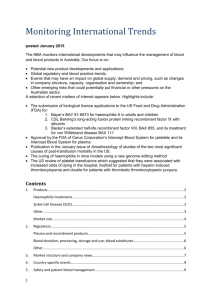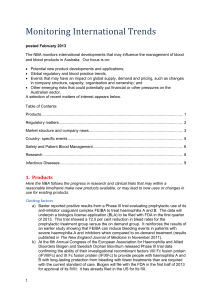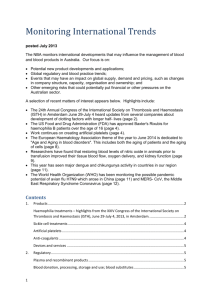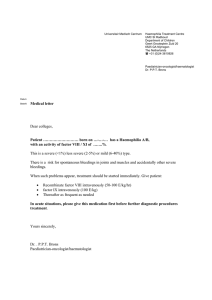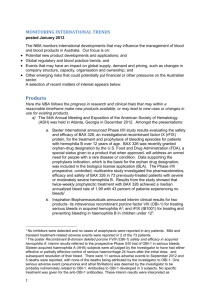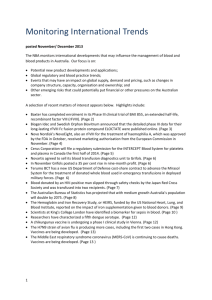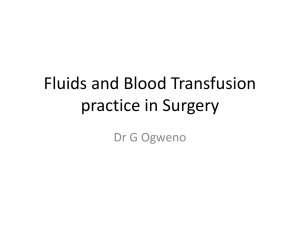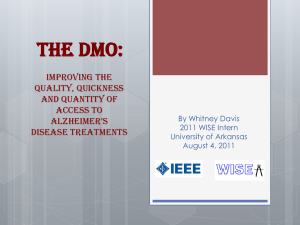NBA - Monitoring Internation Trends
advertisement
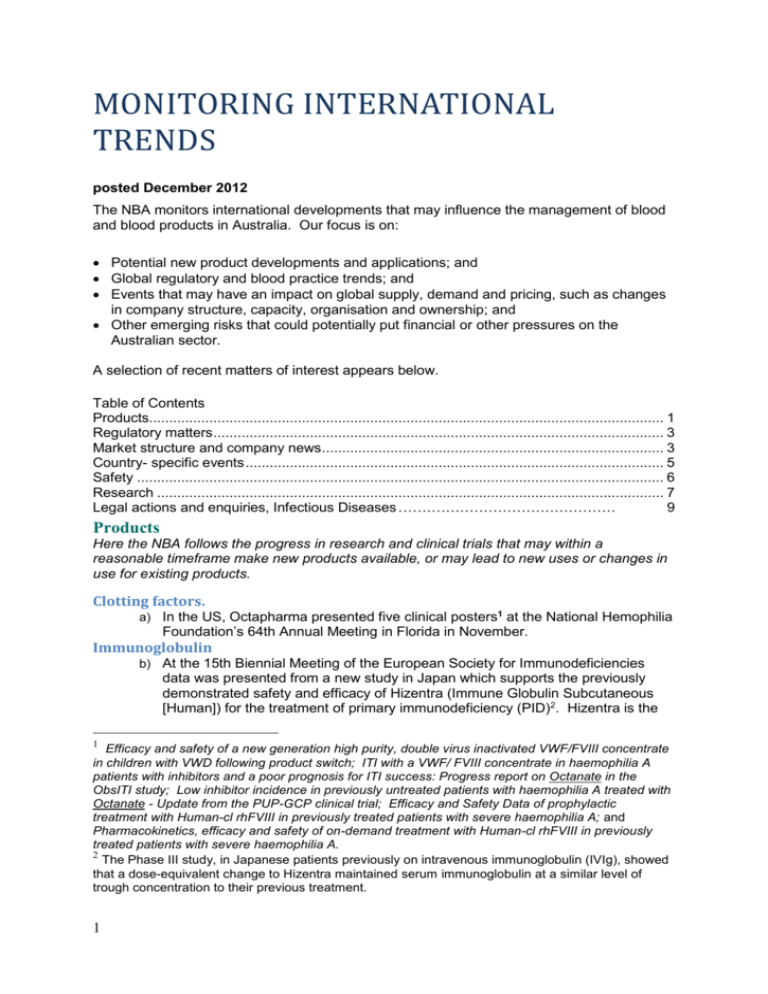
MONITORING INTERNATIONAL TRENDS posted December 2012 The NBA monitors international developments that may influence the management of blood and blood products in Australia. Our focus is on: Potential new product developments and applications; and Global regulatory and blood practice trends; and Events that may have an impact on global supply, demand and pricing, such as changes in company structure, capacity, organisation and ownership; and Other emerging risks that could potentially put financial or other pressures on the Australian sector. A selection of recent matters of interest appears below. Table of Contents Products................................................................................................................................ 1 Regulatory matters ................................................................................................................ 3 Market structure and company news ..................................................................................... 3 Country- specific events ........................................................................................................ 5 Safety ................................................................................................................................... 6 Research .............................................................................................................................. 7 Legal actions and enquiries, Infectious Diseases . ……………………………………… 9 Products Here the NBA follows the progress in research and clinical trials that may within a reasonable timeframe make new products available, or may lead to new uses or changes in use for existing products. Clotting factors. a) In the US, Octapharma presented five clinical posters1 at the National Hemophilia Foundation’s 64th Annual Meeting in Florida in November. Immunoglobulin b) At the 15th Biennial Meeting of the European Society for Immunodeficiencies data was presented from a new study in Japan which supports the previously demonstrated safety and efficacy of Hizentra (Immune Globulin Subcutaneous [Human]) for the treatment of primary immunodeficiency (PID)2. Hizentra is the 1 Efficacy and safety of a new generation high purity, double virus inactivated VWF/FVIII concentrate in children with VWD following product switch; ITI with a VWF/ FVIII concentrate in haemophilia A patients with inhibitors and a poor prognosis for ITI success: Progress report on Octanate in the ObsITI study; Low inhibitor incidence in previously untreated patients with haemophilia A treated with Octanate - Update from the PUP-GCP clinical trial; Efficacy and Safety Data of prophylactic treatment with Human-cl rhFVIII in previously treated patients with severe haemophilia A; and Pharmacokinetics, efficacy and safety of on-demand treatment with Human-cl rhFVIII in previously treated patients with severe haemophilia A. 2 The Phase III study, in Japanese patients previously on intravenous immunoglobulin (IVIg), showed that a dose-equivalent change to Hizentra maintained serum immunoglobulin at a similar level of trough concentration to their previous treatment. 1 first and so far the only 20 percent subcutaneous immunoglobulin (SCIg) therapy in the world for the treatment of PID. CSL Behring submitted the new drug application for Hizentra to the Pharmaceutical and Medicines Devices Agency in Japan in September c) A recent assessment3 confirmed that a high level of health-related quality of life can be achieved for patients managing hereditary angioedema, when treatment such as C1-inhibitor concentrate is available. Patient Blood Management d) At the 2012 Annual Meeting of the American Society of Hematology (ASH) in December in Atlanta, AMAG Pharmaceuticals presented four abstracts 4. They contained new data on Feraheme (ferumoxytol) injections for intravenous (IV) use in patients with iron deficiency anaemia and a history of unsuccessful oral iron therapy e) A team at Johns Hopkins University has created HemoGlobe, a small device that allows health workers in the field to use the computing power of a cell phone to screen for anaemia. The HemoGlobe is an inexpensive sensor connected to the cell phone. The sensor resembles those used to measure blood oxygen levels, and attaches to tip of a finger. A light shines through the finger and the sensor detects the colour of the blood through the skin along various wavelengths. The specific colour indicates the specific level of haemoglobin. The cell phone displays the result- a color-coded readout indicating whether the patient is anaemic, and the degree of severity. HemoGlobe can automatically send the output as a text message to a server set up to produce an epidemiological map of anaemia cases in the area. Other Adventrix Isomark, based in Madison, Wisconsin, hopes to launch a sepsis detection device in late 2014. In contrast with conventional methods of detection (which measure heart rate, blood pressure and temperature), this new device measures two isotopes of carbon found in a patient’s breath. By measuring both carbon 12 and carbon 13, and detecting changes in their ratio, scientists can see when the body is metabolizing in a way specifically associated with an infection. The clinical trial with 33 patients showed that the device detected sepsis, in one case 48 hours before and in another case 12 hours earlier than conventional methods. g) Norwegian company SpinChip has developed a device claimed to draw a blood sample directly from a fingertip into small analytical chips that are placed in a microcentrifuge. The analysis can be read optically within a few minutes. This portable instrument can move from laboratory to bedside to surgery. Development work on SpinChip will continue to 2015. h) Kamada’s drug Glassia, used in alpha-1 atrypsin deficiency, is now claimed to have other therapeutic indications. Kamada says it shows promise in treating bacterial lung infection, as an anti inflammatory agent in chronic obstructive pulmonary disease, and in the prevention of transplant rejection. A Phase II f) 3 in Allergy & Asthma Proceedings "Ferumoxytol Treatment Results in Robust Hemoglobin Increases in Iron Deficiency Anemia Patients with a History of Unsatisfactory Oral Iron Therapy in a Phase III, Randomized, PlaceboControlled Trial" (Vadhan-Raj, et. al.); "Potential New Treatment Option for Iron Deficiency Anemia Patients with a History of Unsatisfactory Oral Iron Therapy- Results of a Phase III, Randomized, Open-Label, Active-Controlled Trial of Ferumoxytol" (Hetzel, et. al.); "Efficacy of Total Dose Administration (TDI) of 1012 Mg of Ferumoxytol Over 15 Minutes for the Treatment of Iron Deficient Anemia" (Auerbach, et. al.): "Ferumoxytol Treatment Demonstrates Significant Improvements in Fatigue and Health-Related Quality of Life in Iron Deficiency Anemia Patients with a History of Unsatisfactory Oral Iron Therapy" (Vadhan-Raj, et. al.) All available on the ASH website at www.hematology.org 4 2 i) j) study has also been conducted in Type 1 diabetes. Kamada says its AAT protein is modulating the activity of type B lymphocytes and thus enabling the avoidance of organ transplant rejection. The company says that in the presence of its AAT protein in serum, pro-inflammatory proteins are inhibited. CSL is studying CSL 112 to reduce the risk of recurrent heart attacks. Data from pilot studies of this formulation of apolipoprotein A-I were presented in Los Angeles at the American Heart Association 2012 Scientific Sessions. Apolipoprotein A-I is the main component of high-density lipoprotein (HDL), which plays a role in the removal of cholesterol from arteries. Oxygen Biotherapeutics is developing its proprietary perfluorocarbon-based intravenous emulsion, Oxycyte as a treatment for a variety of ischemic conditions. Its US Army-funded preclinical program is addressing safety questions raised by the US Food and Drug Administration (FDA). Meanwhile, clinical studies of Oxycyte in patients with traumatic brain injury are being conducted outside the US. Regulatory Matters The NBA monitors overseas regulatory decisions on products, processes or procedures which are or may be of relevance to its responsibilities. a) Cytomedix has been given FDA clearance for its Angel Concentrated Platelet Rich Plasma (cPRP) System to process small samples of blood or mixtures of blood and bone marrow aspirate. This is mixed with bone graft material for use in orthopaedic procedures including spinal fusion. The automated system is designed to produce high platelet yields. b) The FDA investigated a significant number of post-marketing reports of gastrointestinal bleeding in patients who were treated with the Pradaxa bloodthinner, approved two years ago. It concluded that the bleeding rates are no higher than with warfarin. However, there is no agreed antidote to reverse the effects of Pradaxa, and the FDA report did not address this issue. c) The FDA has agreed Cerus may submit a premarket application for approval of its plasma safety system. "Based on recent positive discussions with the FDA, Cerus now plans to move forward with a modular premarket approval application for the Intercept blood system for plasma in the United States," President and CEO William Greenman said in a press release. Cerus lost $US14.2 million on revenue of $US26.3 million in the nine months ended 30 September. That compares with a loss of $US9.2 million on revenue of $US22.6 million in the same period of 2011. d) The FDA has approved Bayer’s oral anticoagulant Xarelto (rivaroxaban) for the treatment of deep vein thrombosis (DVT), pulmonary embolism (PE), and to reduce the risk of recurrent DVT and PE. Market Structure and Company News The NBA’s business intelligence follows company profitability, business forecasts, capital raisings or returns, mergers and takeovers, arrangements for joint research and/or development, contracts for supply of manufacturing inputs, and marketing agreements. Companies considered include suppliers, potential suppliers and developers of products which may be of interest. a) Cerus Corporation in November compared the first nine months of 2012 with the same period in 2011. Although its product revenue increased by 26 per cent its operating expenses were higher and there was much less government grant 3 b) c) d) e) f) 5 revenue to recognize in 2012. The company is planning a modular5 Premarket Approval Application for the INTERCEPT Blood System for plasma in the US. It believes its existing clinical data will be enough to begin the submission process. Grifols announced the results of the fifth round of the Martín Villar Research Awards on Hemostasis. The projects receiving awards were: Reduction in bleeding episodes associated with hemophilia with laboratory engineered proteins using mutagenesis techniques6 New progress in non-invasive prenatal diagnosis for female carriers of the hemophilia gene7 Targeting of impaired genes in the DNA of hemophilic mice and subsequent restoration of hemostasis8. Baxter International has announced an exclusive 20-year partnership with Hemobrás (Empresa Brasileira de Hemoderivados e Biotechnologia) to provide haemophilia A patients in Brazil with more access to recombinant factor VIII (rFVIII). The majority of Brazilian patients currently receive plasma-derived FVIII (pdFVIII). Baxter will have exclusive access to Brazil's rFVIII market over the next 10 years while the companies engage in technology transfer to develop manufacturing capacity by Hemobrás. Baxter will be paid in cash for product it supplies to Hemobrás and then royalties on rFVIII produced by Hemobrás. Geoffrey McDonough, CEO of Swedish Orphan Biovitrum (SOBI) reported: "The third quarter continued to demonstrate solid underlying growth in product sales and an improvement of the gross margin in line with our expectations. In September we reported positive top-line results from our factor IX phase III program with Biogen Idec for the development of a long-lasting recombinant coagulation factor for haemophilia B." Santarus' CEO spoke to Lazard Capital Markets’ Ninth Annual Healthcare Conference in November about Ruconest, the company’s recombinant human c1 esterase inhibitor, being studied for acute hereditary angioedema attack. The product is currently approved in Europe and sold by Swedish Orphan Biovitrum. Results from a third Phase III study showed a very good safety profile. There are two plasma derived esterase c1 inhibitors on the market: Cinryze for prophylactic treatment of hereditary angioedema (HAE) and Berinert for acute treatment. Santaurus believes its recombinant product has a safety advantage. ProMetic Life Sciences reversed last year’s loss, reporting it had a $C2.5 million net profit in the third quarter, when its revenue was $C7.7 million The financial report came six weeks after ProMetic announced that China’s Shenzhen Hepalink Pharmaceutical Co. Ltd. would take a 10 per cent stake in the Canadian company and its protein technology. The modular process is a compilation of sections submitted at varying times that together constitute a complete application. This approach allows applicants to resolve deficiencies in the application as they are identified by the FDA. 6 The first prize, worth 25,000 euros, has been awarded to Dr. Lacramioara Ivanciu for her innovative strategy in protein engineering by means of rational mutagenesis in haemophilic mice, whereby it is possible to modulate FXa function and avoid bleeding episodes. The publication describes how a Xa Factor variant, structurally homologous to the zymogen -the still inactive enzyme- is able to intervene in the coagulation activation mechanisms and to correct the haemostatic imbalance which leads to bleeding episodes in this illness. 7 The panel awarded the second prize, of 10,000 euros to Dr. Rezan A. Kadir for the development of a non-invasive prenatal diagnostic test that analyzes maternal plasma DNA in women carrying specific haemophilia gene mutations who are pregnant with male foetuses. This new technique is able to determine whether the foetus has inherited a causative mutation for haemophilia from its mother. 8 The third and final prize, worth 5,000 euros, was awarded to Dr. Katherine A. High for her research into a reverse-engineered genetic method using zinc finger nucleases. These enzymes are engineered to identify accurately the mutant gene in mice with haemophilia A. 4 g) Pfizer, a major supplier of drugs to the NHS, avoided paying any corporation tax in the UK last year. The UK Government is cracking down on companies that reduce their tax bills by recognising profits in countries with lower tax regimes. Pfizer has already faced questions over its tax arrangements in the US and Germany. h) NuSep, a company listed on the Australian Stock Exchange, has received Australian Therapeutic Goods Administration (TGA) accreditation to manufacture in-vitro diagnostics medical devices (IVDs) used in the field of coagulation. The TGA certification will help NuSep to supply PrIME Biologics with cartridges to manufacture therapeutic plasma products. NuSep is currently in the process of spinning out its therapeutic plasma fractionation business, PrIME Biologics. The latter is concentrating on opening up the Asian therapeutic plasma market, particularly the untapped Currently Unprocessable Plasma (CUP) market. Country- specific Events The NBA is interested in relevant safety issues which arise in particular countries, and also instances of good practice. We monitor health issues in countries from which Australia’s visitors and immigrants come. United States a) By 9 November 2012, 32 people are known to have died and 438 have become ill from an outbreak of fungal meningitis linked to contaminated steroid injections from a compounding pharmacy. b) Biogen Idec, two patient advocacy groups, and a medical centre have combined to offer no- cost or low-cost genetic testing in the US to people with haemophilia and their families. This will identify ways to personalize patient care, generate new genetic information, and help create a database for use in research. The National Hemophilia Foundation said that the project - My Life, Our Future: Genotyping for Progress in Hemophilia- will provide genetic and clinical information to clinicians, researchers, and patients by overcoming the main constraint on genetic testing — cost and insurance coverage9. c) At the annual scientific sessions of the American Association of Blood Banks (AABB), in Boston in October initial results were presented for Imugen’s new investigational blood tests to screen blood donors for babesiosis. By then around 20,000 blood donors had been tested by nucleic acid tests and also by a new serologic test method. Babesiosis is currently the most common infectious disease transmitted by blood in the US. As a result of this testing, 69 blood units that were potentially infectious for Babesia were removed from the blood supply. These studies will finish early in 2013, and will be the basis of an application to the FDA to approve the test. Australia d) The Australian Bureau of Statistics (ABS) in November released the highest life expectancy estimates ever recorded in Australia10 . Director of ABS Demography, Bjorn Jarvis, said that life expectancy figures continued to increase over the ten year period ending 2011."Under current estimates, a boy born today could expect to live 79.7 years while a girl could expect to live 84.2. A male currently aged 65 could expect to live a further 19 years and female a further 22 years," Mr Jarvis 9 Biogen, will provide the financial support for the initiative, as well as scientific advice and project management. The company will not receive special access to the data or samples involved. The testing program will be made available through participating haemophilia treatment centres beginning in 2013 10 ABS, Deaths, Australia, 2011 (cat. no. 3302.0). State, territory and sub-state information is also available for download from www.abs.gov.au 5 said." According to United Nations estimates, Australia’s male and female combined life expectancy figure of 81.4 years is higher than the rates in the UK, Canada, New Zealand and the USA. e) A report has been released by the Advisory Council on Intellectual Property, which was appointed in 2010 by the former Minister for Innovation, Industry, Science and Research, Senator the Hon Kim Carr, to review how intellectual property acts as an enabler or disabler for research collaborations. The report has offered recommendations to improve research collaborations, including reforming the incentive structures that discourages researchers from working with the private sector11. The full review can be found on the Advisory Council on Intellectual Property website. Other f) The complete implementation of an EU Blood Directive was postponed in Ireland after it made the blood supply “very difficult” in July and August. The Irish Blood Transfusion Service had, in line with the Directive, implemented a policy to defer donations from people with low haemoglobin. The deferral rate in clinics had increased from an average of 15 per cent to 22 per cent. Chief Executive of the IBTS Andrew Kelly announced it would for the next year need to accept blood from women with a haemoglobin count of between 12 and 12.4gm/dl and men of 13 and 13.4gm/dl. Safety Issues We follow current issues in patient safety. a) Early in-hospital mortality in adult trauma patients is predicted by transfusion proctocol employed, according to an article12 in the Archives of Surgery. Where haemorrhage was the primary cause of death, the chance of death within six hours of admission was significantly and negatively associated with increased transfusion rates of plasma to red blood cells and with platelets to red blood cells. The authors suggested a randomized trial to examine the potential net survival benefit of early and higher plasma and platelet ratios. b) A recent article13 reported that data from the Australian Better Safer Transfusion programme show that about one-third of patients undergoing hip or knee arthroplasty receive perioperative blood transfusions, placing them at increased risk for adverse clinical outcomes. The authors described challenges associated with the provision of allogenic blood transfusions including the quality of stored red cells, cost of blood, and limited donors and suggested a new approach to transfusion management. This included pre-operative optimization of haemoglobin and iron levels, and intraoperative management of blood loss. c) A new study reports that three- quarters of patients on blood thinners clopidogrel and prasugrel are on the incorrect dose and could be at risk for either 11 Researchers, particularly early in their career, are so dependent on Australian Research Council (ARC) and National Health and Medical Research Council (NHMRC) funding that they are reluctant to undertake activity that could reduce their chances of receiving competitive grants. Collaborations with industry are not recognised in awarding ARC and NHMRC grants, so researchers focus on publicly funded research. 12 By John Holcomb et al, University of Texas Health Sciences Center, Houston 13 Bruce W, Campbell D, Daly D, Isbister J, “Practical recommendations for patient blood management and the reduction of perioperative transfusion in joint replacement surgery”. ANZ J Surg. 2012 Nov 1. doi: 10.1111/ans.12000. [Epub ahead of print] 6 d) e) f) g) h) i) uncontrolled bleeding or blood clots14. They found that age, gender, cholesterol levels and history of heart problems were not good predictors for how a patient would react to the blood thinners. They recommended a simple blood test to personalize dosing. A pilot study15 showed an optical scanner for Apple’s iPad tablet computer reliably estimated blood loss during surgery in both experimental and clinical settings. Precise measurement facilitates haemodtnamic stability of the patient and assists anaesthetists in deciding if and when to transfuse. A Canadian study16 found no difference in outcomes for premature babies between the transfusion of blood stored for a week or less and blood stored for a mean of two weeks. Following the death of a Hong Kong woman from septic shock after receiving platelet rich plasma injections as a beauty treatment, two cosmetology hospitals in Shanghai were investigated. Platelet rich plasma injections (PRP) are not approved by Chinese health authorities. Sumeet Goswami (College of Physicians and Surgeons of Columbia University, New York, USA) and team reported in Anesthesiology that patients who receive intraoperative blood transfusion are at increased risk of intraoperative cardiac arrest (ICA); and that as the number of transfused units of blood rises, so does a patient's risk for ICA. In the study, ICA occurred at an approximate rate of seven cases per 10,000 noncardiac surgeries and carried a 30-day postoperative death risk of 63 per cent. The authors suggested primary prevention might be the key to reducing mortality from ICA17. Pluristem Therapeutics said a second of the three patients given the company’s experimental stem cells had now died, although their lives had been extended by the treatment. Research has suggested that patients undergoing bilateral knee replacement with regional anaesthesia are less likely to receive transfused blood than those who have general anaesthesia18. Research A wide range of scientific research has some potential to affect the use of blood and blood products. However, research projects have time horizons which vary from “useful tomorrow” to “at least ten years away”. Likelihood of success of particular projects varies, and even research which achieves its desired scientific outcomes may not lead to scaled- up production, clinical trials, regulatory approval and market development. a) A Tulane researcher has received a $US2 million grant from the National Institutes of Health to develop technology to remove the damaged red blood cells from stored blood during transfusion. 14 Researchers at the Intermountain Medical Center Heart Institute in Salt Lake City considered over 500 patients and found half of those taking Plavix were getting too little to effectively prevent blood clots, while a quarter were getting too much. 15 Siddarth Satish, and his colleagues reported at the 2012 annual meeting of the American Society of Anesthesiologists (abstract 809). 16 led by Dean Fergusson of the Ottawa Hospital Research Institute and published in the Journal of the American Medical Association to coincide with the AABB Annual Meeting in Boston. 17 Data came from the American College of Surgeons National Surgical Quality Improvement Program database where the intra- and postoperative outcomes of 362,767 non-cardiac surgery patients were recorded. Other predictors of ICA risk identified were emergency surgery and impaired preoperative patient functioning, both factors doubling the risk for ICA during non-cardiac surgery. 18 Stavros Memtsoudis (Hospital for Special Surgery, New York) in Regional Anesthesia and Pain Medicine. 7 b) Researchers at Brigham and Women's Hospital19 have identified a gene that regulates haemoglobin synthesis during the formation of red blood cells20. c) Scientists from Stanford University School of Medicine have used bioengineered mice (whose livers consist mostly of human cells) to characterize a drug about to enter early-stage clinical development for combating hepatitis C21. d) Portola Pharmaceuticals has a deal with Bristol-Myers Squibb and Pfizer to test an experimental treatment PRT 4445 to reverse the effect of blood-thinning Factor Xa inhibitor drugs. e) The Monash Institute of Pharmaceutical Sciences won a $1 million grant from the Bill and Melinda Gates Foundation's Grand Challenges Explorations initiative, to develop an inhaled version of oxytocin, used to treat post-partum haemorrhage. The grant will help move the project to human trials in 2013. f) At the 2012 American Society of Nephrology (ASN) Kidney Week meeting, researchers from Chosun University Hospital in Gwangju, advised that intravenous ascorbic acid can be a potent and effective adjuvant treatment for hemodialysis patients who have normoferritinemic anemia resistant to treatment with erythropoietin (EPO). They said intravenous ascorbic acid can also decrease the dosage of erythropoiesis-stimulating agents (ESAs) for anaemia correction. g) Also at the Kidney Week meeting Affymax and Takeda presented post-hoc subgroup analyses of the EMERALD Phase III studies that evaluated OMONTYS (peginesatide) injection, an ESA, for the treatment of anaemia due to chronic kidney disease (CKD) in adult dialysis patients. h) Keryx Biopharmaceuticals announced the initiation of a Phase II study of Zerenex™ (ferric citrate), its ferric iron-based phosphate binder drug candidate, in managing serum phosphorus and iron deficiency in anaemic patients with Stage 3 to 5 non-dialysis dependent chronic kidney disease. j) Once-daily, oral avatrombopag was found efficacious for the treatment of thrombocytopenia in patients with chronic liver disease, prior to elective procedures22. k) MRC Technology23 received a £577,000 award from The Biomedical Catalyst24 to fund research into the role of cytokine IL-16 in Ischemic Reperfusion Injury (IRI), the tissue damage and subsequent inflammatory response arising from a sudden loss of blood flow, for example during surgery or as a result of a blood clot. MRC Technology aims to deliver a humanized anti-IL-16 antibody, together with efficacy, pharmacokinetic, and toxicology data in mammalian models. It would then partner with a pharmaceutical company to move into clinical trials. l) Recent research suggested that IVIg may offer significant relief for neuropathic pain25. If this were to become a widely accepted/ approved use it would have a significant impact on global demand for IVIg, and hence its price. 19 www.brighamandwomens.org The study was published online on November 7, 2012 in Nature. 21 Tests using the mouse model predicted important aspects of the drug’s behaviour in humans — including its interaction with another drug and the profile of its major breakdown products (or matabolites) in the body (called metabolites) — more accurately. The study was published online Oct. 31 in the Journal of Pharmacology and Experimental Therapeutics. 22 Norah Terrault and colleagues, presenting at: The Liver Meeting 2012; Nov. 9-13, Boston. 23 .MRC Technology is the technology transfer agent for the UK’s Medical Research Council. 24 The Biomedical Catalyst is a public funding program to grow the UK life sciences sector. It is supported by the Medical Research Council and the Technology Strategy Board. 25 Stefano Jann, et al, “Efficacy and Safety of Intravenous Immunoglobulin as Adjuvant Treatment for Refractory Neuropathic Pain. Results of an Open-Label, Multicenter Study”, Pain Medicine, Oct 2012;13(10) pp 1334-1341. DOI:10.1111/j.1526-4637.2012.01478.x 20 8 m) Canadian and Italian stem cell scientists have identified a new "master control gene" for human blood stem cells, and discovered that manipulating its levels might create a way to expand these cells for clinical use26. n) With IVIg being trialled as a treatment for Alzheimer’s disease, the NBA – concerned about market pressure if the trial result is positive- takes an interest in research on other possible treatments for Alzheimer’s: Purdue University’s Professor Arun Ghosh has designed a new molecule, a highly potent beta-secretase inhibitor with features that ensure it attacks only its target and not healthy physiological processes. "This molecule maintains the disease-fighting properties of earlier beta-secretase inhibitors, but is much less likely to cause harmful side effects," said Ghosh. The journal Neurology reported on 24 October that recent data from a longterm study of hormone replacement therapy suggests that women who started the therapy within five years of menopause were 30 percent less likely to develop Alzheimer's disease than women who started later. Most professional societies in the US advise against hormone therapy for chronic disease prevention, including the American Heart Association, the American Congress of Obstetricians and Gynecologists and the American Academy of Family Physicians. Spain's Zeltia announced results from a mid-stage trial of tideglusib, a glycogen synthase kinase 3 (GSK-3) inhibitor. The primary cognitive endpoint and two of the secondary endpoints were not met in the 26-week ARGO Phase IIb trial. University of California at Irvine researchers have created a new stem cellderived cell type (choroid plexus epithelial cells) with particular promise for treating neurodegenerative diseases such as Alzheimer's. Husseini Manji, head of neuroscience at Johnson and Johnson, said researchers are still reviewing disappointing bapineuzumab studies to see whether there are signs the drug may slow the progression of dementia if taken earlier. Although bapineuzumab was trialled on the basis of the beta amyloid theory of Alzheimer’s, additional analysis is being conducted on whether the drug reduces tau, a tangled protein found in the brains of those with Alzheimer’s. “We remain optimistic there is something there,” Manji said. J&J is expecting to see more data on intravenous bapineuzumab from studies conducted by Pfizer, its partner in the drug. Other investigators on the amyloid beta side of the scientific argument are also moving to treat the disease while it's still in its earliest stages, believing that established cases are too far along to treat, an understanding which appeared to come out of Eli Lilly's solanezumab study. How soon can Alzheimer’s disease be detected? Scientists from the US and Colombia tested 18- to 26-year-old members of an extended Colombian family. One-in-three members have a genetic mutation associated with a rare form of the disease which attacks them in their 40s. Brain scans found that people with the mutated gene have less grey matter in particular areas of their brains, scientists reported in The Lancet. Those with the mutation also had higher levels of amyloid beta in their cerebrospinal fluid (amyloid beta is implicated in the plaque build-ups found on the brains of Alzheimer's sufferers. The findings "suggest that neurodegenerative changes occur more 26 Eric R. Lechman, Bernhard Gentner, Peter van Galen, Alice Giustacchini, Massimo Saini, Francesco E. Boccalatte, Hidefumi Hiramatsu, Umberto Restuccia, Angela Bachi, Veronique Voisin, Gary D. Bader, John E. Dick, Luigi Naldini. “Attenuation of miR-126 Activity Expands HSC In Vivo without Exhaustion”. Cell Stem Cell, 2012; DOI: 10.1016/j.stem.2012.09.001 9 than 20 years before symptom onset and somewhat earlier than was suggested by findings from previous MRI studies," Nick Fox of University College London's Dementia Research Centre said. He questioned current models of Alzheimer’s since neurodegeneration appears to be occurring in advance of the appearance of plaque in the brain. Claude Wishik, a supporter of the tau theory rather than the beta amyloid theory of Alzheimer’s, founded a company TauRx which recently announced the launch of a late-stage program to test its drug. Could Alzheimer's be triggered by both proteins? Roche which has a big amyloid beta program underway with AC Immune, recently went back to inlicense AC's tau program. TransTech Pharma thinks Pfizer was mistaken some years ago when it stopped part of a study of an Alzheimer’s drug in which the companies were partners. With the study data and full ownership of the drug, TransTech plans to move on, probably with a Phase III trial of about 800 patients starting in 2013. The drug, known as TTP488 at TransTech, targets mild to moderate forms of the disease. Legal issues The NBA is interested in the implications for Australia of any proceedings against companies, governments and professional practitioners in relation to blood and blood products; or of relevant public enquiries a) In Scotland, the Penrose Inquiry into contaminated NHS blood products in the 1980s will take further written evidence. Lord Penrose refused an application from the Haemophilia Society to reopen the oral hearings stage to call expert witnesses on the topic of statistics. The final report will be published in 2013. Infectious diseases The NBA takes an interest in infectious diseases because: the presence of disease in individual donors (e.g. influenza), or potential disease resulting from travel (e.g. malaria) means a donor must be deferred; temporary disease burden within a community (e.g. dengue in North Queensland) may limit blood collection in the community for a time; and some people may not be permitted to donate at all (e.g. people who lived in the UK for a period critical in the history of vCJD). Blood donations are tested for a number of diseases (e.g. HIV and Hepatitis B), but there are also emerging infectious diseases for which it may become necessary to test in the future (e.g. Chagas disease, and the tick-borne babesiosis and Lyme disease). Mosquito- borne diseases a) The US West Nile virus epidemic of 2012, the worst in a decade, will be remembered for a different reason: The virus, in some patients, has been attacking the brain more aggressively than in the past, according to neurologists experienced in dealing with the illness. They suspect the virus has changed, a view supported by a Texas virologist whose laboratory has found signs of genetic changes in virus collected from the Houston area. Furthermore, in the past the virus has typically invaded the brain and spinal cord only of people who have weakened immune systems, but this summer it has also severely affected younger and stronger people, sometimes causing paralysis and recurring seizures. Many of these patients who have suffered neuroinvasive effects will be disabled for life. Influenza b) Novavax reported results from two Phase 1 trials of its pandemic influenza vaccine. Safety and immunogenicity endpoints were met in both trials. c) MonoSol Rx and BiondVax are working together to develop an oral film formulation of the universal flu vaccine, M-001. MonoSol’s PharmFilm is a quick- 10 dissolving, taste-masked dissolvable film that MonoSol says has the potential for faster onset and more precise dosing for patients whose medical conditions or patient profiles challenge compliance with traditional drug delivery. BiondVax’ universal flu vaccine, M-001, relies on a combination of conserved constant epitopes, or peptides, common to existing and future flu virus strains, both seasonal and pandemic, such as the swine and avian flu, irrespective of their antigenic drift and shifts. d) Canadian company Medicago is focused on developing vaccines based on proprietary manufacturing technologies and Virus-Like Particles ("VLPs"). It reported: "In the third quarter of 2012, we announced that we had successfully produced significantly more than 10 million doses of H1N1 influenza VLP vaccine at our commercial-scale facility in North Carolina and completed the DARPA project. In addition, we announced FDA authorization to initiate a Phase I clinical trial with the Infectious Diseases Research Institute (IDRI) for an H5N1 VLP vaccine to explore the possibility of enhanced protection with one dose of vaccine, continued development of the quadrivalent seasonal flu vaccine, and signed a commercial agreement with Philip Morris Products for influenza vaccines in China. In 2013, we expect to see results from at least three clinical trials, which would reinforce our position with governments and companies to secure revenues and grant opportunities." e) The FDA’s Vaccines and Related Biological Products Advisory Committee voted 14-0 that the influenza A (H5N1) Virus Monovalent Vaccine produced by GSK should be approved based on clinical studies. GlaxoSmithKline contracted with the US government to develop the vaccine, which includes an antigen-saving adjuvant that boosts the immune response. If licensed, it will be taken into the US Strategic National Stockpile. f) At the Influenza Congress USA in Washington on November 12, 2012, Dr. Samuel Bogoch of Bioradar UK Ltd discussed how synthetic Replikin vaccines may prevent the development of influenza virus outbreaks and pandemics. Other g) Concern continues about a novel coronavirus which has appeared. One case confirmed by the Ministry of Health in Saudi Arabia on 4 November was quickly said to have no epidemiological links with two cases which appeared earlier. However, this new case and one of the others had both visited a farm in the recent past. h) Some researchers27 are concerned about the safety of farmed fish as human food because they may acquire infectious prions from cows with mad cow disease or bovine spongiform encephalopathy. The American Heart Association recommends two servings of fish per week. i) A Canadian-made HIV vaccine in human clinical trials was reported to show no adverse effects and to significantly boost immunity. Developed by researchers at Western University in London, Ontario, it is uniquely based on a genetically modified killed whole-virus. j) The Texas Biomedical Research Center has been awarded $US2 million to develop a test for Chagas disease. Tests can easily detect the parasite in the blood, but there is currently no way to determine reliably if, following treatment, any remain in the heart. k) Vaxxas, a company founded in Mark Kendall’s laboratory at the University of Queensland, is establishing representation in Cambridge, Massachusetts. Vaxxas has a research collaboration with Merck. Merck will provide extra research funding to Vaxxas to test its Nanopatch technology. Merck has an exclusive license to use the Vaxxas technology to help develop one undisclosed 27 Robert P. Friedland of Department of Neurology, University of Louisville School of Medicine, Louisville, KY, USA and colleagues published a report in eJournal of Alzheimer's Disease 11 vaccine candidate in its pipeline. The Nanopatch is loaded with tens of thousands of microneedles per centimetre that can deliver tiny doses of vaccine just beneath the skin. The patch is slapped on with a spring-loaded applicator for a couple of minutes to give a response in immune cells just under the skin. The procedure is supposed to be painless and requires a smaller dose than needles and syringes, and may enable stable vaccines that do not need refrigeration. 12


